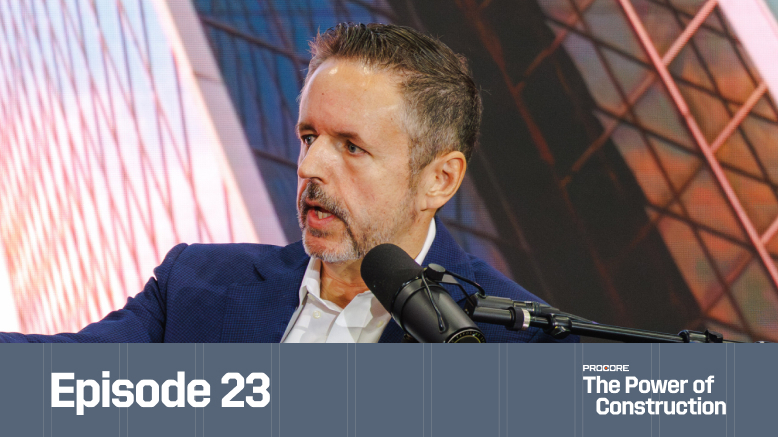— 5 min read
Ounce of Prevention: Avoiding the Top 5 Mistakes of Preconstruction
Last Updated Nov 14, 2025
Bruno Pasini
Senior Solutions Engineer, Overlay, PM & Preconstruction
Bruno Pasini is a Solutions Engineer at Procore, where he develops new tools to simplify and streamline the preconstruction process. He spent nearly 20 years as an estimator and project manager for general contractors and specialty contractors in New York and California. He currently lives in San Diego.
Diane McCormick
Writer
47 articles
Diane McCormick is a freelance journalist covering construction, packaging, manufacturing, natural gas distribution, and waste oil recycling. A proud resident of Harrisburg, PA, Diane is well-versed in several types of digital and print media. Recognized as one of the premier voices in her region, she was recognized as the Keystone Media Freelance Journalist of the Year in 2022 and again in 2023.
Last Updated Nov 14, 2025

In construction, the attention lavished on preconstruction pays off in a project completed on time, on budget, and of the highest quality. Preconstruction mistakes, on the other hand, can balloon into time-consuming rework, costly errors, and quality slip-ups.
This article explores how the five most common mistakes of preconstruction happen, their consequences, and the solutions found in communication and transparency.
Table of contents
The Keys to Success
Construction pros know the “project management triangle” as a guide for prioritizing time, cost, or quality in every decision.
Even when the choice demands trade-offs — which is usually the case — the goal is achieving balance through optimization.
Sometimes, you have to pick your poison. Time or cost?
Bruno Pasini
Senior Solutions Engineer, Overlay, PM & Preconstruction
Procore Technologies
Imbalances happen when information is scant and execution is careless, and they are the fuel for the top five preconstruction mistakes. The solutions are steeped in procedures designed to avert costly mistakes and excess risk.
Mistake #1: Unclear Scope Definition
Poorly defined assignments can let critical tasks fall through the cracks. The danger often lurks at the intersection of MEP trades, in those gray areas where one or the other could install a connection or a pipeline. For instance, responsibility for condensate lines could belong to HVAC or plumbing.
Unclear or absent scope definition leaves room for the trades to point fingers at each other for tasks left undone. The designer or GC who assumes that someone will do it, without writing it into anyone’s scope, faces unplanned costs and schedule disruptions.
In other situations, ambiguous language blurs the parameters of plans, specifications, and schedules. Confusion ensues when a contract calls for the “most stringent” specifications. Does that mean the “most stringent” price savings, timeline, or quality?
You need to be an attorney sometimes to review a bid solicitation package because there is often language that could be interpreted in a multitude of different ways...It depends on who is interpreting that sentence. Semantics can start a wildfire. So the solution is just a lot of questions.
Bruno Pasini
Senior Solutions Engineer, Overlay, PM & Preconstruction
Procore Technologies
Staring at terms that are open to interpretation, readers will often default to the costlier options that make a bid less competitive.
The solution lies in clarification. All terms must be unambiguous, and subcontractors should be encouraged to submit disciplined RFIs that yield answers on intent and exact details.
Mistake #2: Poor Estimating and Budgeting
Just like computers, budgets are “garbage in, garbage out.” Estimates riddled with inaccuracies, assumptions, and holes result in lost profits and liquidated damages.
The solution encompasses these elements for accurate, trustworthy estimates:
Timely Confirmation
The time from conception to bidding can take years, especially in public projects dependent on government allocations. Estimates should be based on the latest available drawings, specifications, and materials.
Clarification
Once again, clarity is key. When a schedule calls for products that are obsolete or unavailable, detailed RFIs extract the next steps and recommendations needed for pinpoint estimates.
RFI Review
A single RFI tells only part of the story. Wait for all RFIs and design changes, and then read them to understand each option in context.
Refreshed Quotes
Today’s product prices and lead times are highly changeable. Stay one step ahead through constant contact with vendors, attending conferences, and cultivating strong professional networks.
We're managing the risks that could arise through the process of pricing something out, executing something, and then providing the warranty that that service was up to a certain level of quality and that will last at least X amount of time.
Bruno Pasini
Senior Solutions Engineer, Overlay, PM & Preconstruction
Procore Technologies
Mistake #3: Incomplete Due Diligence
Every project revolves around strict parameters of site conditions, local codes, and permitting. Failure to research all physical and legal conditions leaves key insights on constructability, lead times, and code compliance stranded. The repercussions generate risk, costs, and inefficiencies.
The solution is making site visits and aligning drawings with every slope and utility line. Those drawings should also reflect the ever-changing local codes, which are updated as regions suffer the effects of natural occurances such as flooding or wildfires.
Mistake #4. Unrealistic Schedules
As construction timelines tighten, aggressive schedules stretch the boundaries of viability. Working under pressure, some designers and contractors skip the sequential dependencies of the critical path and the realistic timelines needed to complete them.
When the MEP and other specialty contractors who know the tasks most intimately aren’t consulted, the time needed for permitting, equipment lead times, site logistics, assembly, and other factors can be underestimated.
A process of early, collaborative scheduling with the trades generates healthy dialogue. Their expertise helps populate schedules with the realities of the work, for timelines honed to their most efficient and cost-effective.
Stay updated on what’s happening in construction.
Subscribe to Blueprint, Procore’s free construction newsletter, to get content from industry experts delivered straight to your inbox.

Mistake #5: Skipping Prequalification
A well-oiled handoff from estimating to construction management positions the right people for the right jobs.
However, some estimators don’t have opportunities to explain their recommendations — the reasoning that led them to choose the higher-priced supplier who can deliver on schedule or the Minority and Women-owned Business Enterprise that helps the project reach MWBE requirements.
Without those explanations, cost-conscious GCs and PMs might elevate their risk by selecting subcontractors and suppliers based on price alone.
A solution of prequalification criteria and systemized notes equips decision makers to award contracts on more than just price. It also drives efficiencies and timelines through assembly of top-flight teams and high-quality materials.
There's no such thing as ‘Oh, you, you worked in this industry so long that you know it all.’ No: If you have that mindset, you will definitely make one of these five mistakes — or all of them.
Bruno Pasini
Senior Solutions Engineer, Overlay, PM & Preconstruction
Procore Technologies
The solutions to avoiding the top 5 preconstruction mistakes emerge from collaboration, effective communication, transparency, systemization, and thorough documentation. Together, they prevent costly errors while bringing value to operations by delivering a project with the cost-time-quality triangle in balance.
Was this article helpful?
Thank you for your submission.
0%
0%
You voted that this article was . Was this a mistake? If so, change your vote
Scroll less, learn more about construction.
Subscribe to The Blueprint, Procore’s construction newsletter, to get content from industry experts delivered straight to your inbox.
By clicking this button, you agree to our Privacy Notice and Terms of Service.
Thank you!
You’re signed up to receive The Blueprint newsletter from Procore. You can unsubscribe at any time.
Categories:
Written by
Bruno Pasini
Senior Solutions Engineer, Overlay, PM & Preconstruction | Procore Technologies
Bruno Pasini is a Solutions Engineer at Procore, where he develops new tools to simplify and streamline the preconstruction process. He spent nearly 20 years as an estimator and project manager for general contractors and specialty contractors in New York and California. He currently lives in San Diego.
View profileDiane McCormick
Writer | Procore Technologies
47 articles
Diane McCormick is a freelance journalist covering construction, packaging, manufacturing, natural gas distribution, and waste oil recycling. A proud resident of Harrisburg, PA, Diane is well-versed in several types of digital and print media. Recognized as one of the premier voices in her region, she was recognized as the Keystone Media Freelance Journalist of the Year in 2022 and again in 2023.
View profileExplore more helpful resources

How Are Partnerships in Construction Being Redefined?
In a market where cost, speed, and quality are table stakes, owners are demanding more than projects delivered on time and on budget. They want trusted partners who bring strategy,...

Bid Triangulation: How Owners, GCs, and SCs Each Benefit
Bids do not live on costs alone: While costs matter, they don’t tell the whole story. A systemized three-bid approach that expands the field of candidates reveals the gaps hiding...

Bid Triangulation: Better Bidding for Better Projects
Systemized bidding lays the groundwork for a project delivered on time and on budget — but true discipline collects multiple quotes to maximize efficiencies and minimize risk. Collecting three bids,...

Who Owns Construction’s Intelligence?
In this episode of The Power of Construction, we chat with Hugh Seaton, CEO of The Link.ai, to step past the buzz around tools and features and unpack what true...
Free Tools
Calculators
Use our calculators to estimate the cost of construction materials for your next project.
Templates
Find a template to help you with your construction project tasks.
Material Price Tracker
Get the latest U.S. retail prices and view historical trends for common building materials.
Glossary
Explore key terms and phrases used in the industry.
